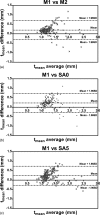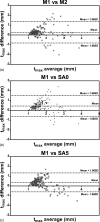Fast plaque burden assessment of the femoral artery using 3D black-blood MRI and automated segmentation
- PMID: 21992357
- PMCID: PMC3189974
- DOI: 10.1118/1.3633899
Fast plaque burden assessment of the femoral artery using 3D black-blood MRI and automated segmentation
Abstract
Purpose: Vessel wall imaging techniques have been introduced to assess the burden of peripheral arterial disease (PAD) in terms of vessel wall thickness, area or volume. Recent advances in a 3D black-blood MRI sequence known as the 3D motion-sensitized driven equilibrium (MSDE) prepared rapid gradient echo sequence (3D MERGE) have allowed the acquisition of vessel wall images with up to 50 cm coverage, facilitating noninvasive and detailed assessment of PAD. This work introduces an algorithm that combines 2D slice-based segmentation and 3D user editing to allow for efficient plaque burden analysis of the femoral artery images acquired using 3D MERGE.
Methods: The 2D slice-based segmentation approach is based on propagating segmentation results of contiguous 2D slices. The 3D image volume was then reformatted using the curved planar reformation (CPR) technique. User editing of the segmented contours was performed on the CPR views taken at different angles. The method was evaluated on six femoral artery images. Vessel wall thickness and area obtained before and after editing on the CPR views were assessed by comparison with manual segmentation. Difference between semiautomatically and manually segmented contours were compared with the difference of the corresponding measurements between two repeated manual segmentations.
Results: The root-mean-square (RMS) errors of the mean wall thickness (t(mean)) and the wall area (WA) of the edited contours were 0.35 mm and 7.1 mm(2), respectively, which are close to the RMS difference between two repeated manual segmentations (RMSE: 0.33 mm in t(mean), 6.6 mm(2) in WA). The time required for the entire semiautomated segmentation process was only 1%-2% of the time required for manual segmentation.
Conclusions: The difference between the boundaries generated by the proposed algorithm and the manually segmented boundary is close to the difference between repeated manual segmentations. The proposed method provides accurate plaque burden measurements, while considerably reducing the analysis time compared to manual review.
Figures












Similar articles
-
Fast segmentation of the femoral arteries from 3D MR images: A tool for rapid assessment of peripheral arterial disease.Med Phys. 2015 May;42(5):2431-48. doi: 10.1118/1.4916803. Med Phys. 2015. PMID: 25979037
-
Assessment of femoral artery atherosclerosis at the adductor canal using 3D black-blood MRI.Clin Radiol. 2013 Apr;68(4):e213-21. doi: 10.1016/j.crad.2012.12.002. Epub 2013 Jan 17. Clin Radiol. 2013. PMID: 23332436
-
Joint segmentation of lumen and outer wall from femoral artery MR images: Towards 3D imaging measurements of peripheral arterial disease.Med Image Anal. 2015 Dec;26(1):120-32. doi: 10.1016/j.media.2015.08.004. Epub 2015 Sep 2. Med Image Anal. 2015. PMID: 26387053
-
Quantifying skeletal muscle volume and shape in humans using MRI: A systematic review of validity and reliability.PLoS One. 2018 Nov 29;13(11):e0207847. doi: 10.1371/journal.pone.0207847. eCollection 2018. PLoS One. 2018. PMID: 30496308 Free PMC article.
-
Advanced techniques for MRI of atherosclerotic plaque.Top Magn Reson Imaging. 2009 Aug;20(4):217-25. doi: 10.1097/RMR.0b013e3181ea2853. Top Magn Reson Imaging. 2009. PMID: 20805732 Free PMC article. Review.
Cited by
-
DANTE-prepared three-dimensional FLASH: A fast isotropic-resolution MR approach to morphological evaluation of the peripheral arterial wall at 3 Tesla.J Magn Reson Imaging. 2016 Feb;43(2):343-51. doi: 10.1002/jmri.24986. Epub 2015 Jul 2. J Magn Reson Imaging. 2016. PMID: 26139414 Free PMC article.
-
Magnetic Resonance Imaging Techniques in Peripheral Arterial Disease.Adv Wound Care (New Rochelle). 2023 Nov;12(11):611-625. doi: 10.1089/wound.2022.0161. Epub 2023 May 23. Adv Wound Care (New Rochelle). 2023. PMID: 37058352 Free PMC article. Review.
-
Automated morphologic analysis of intracranial and extracranial arteries using convolutional neural networks.Br J Radiol. 2022 Oct;95(1139):20210031. doi: 10.1259/bjr.20210031. Epub 2022 Oct 5. Br J Radiol. 2022. PMID: 36018822 Free PMC article.
-
MRI in Lower Extremity Peripheral Arterial Disease: Recent Advancements.Curr Cardiovasc Imaging Rep. 2013 Feb 1;6(1):55-60. doi: 10.1007/s12410-012-9175-z. Curr Cardiovasc Imaging Rep. 2013. PMID: 23336015 Free PMC article.
-
Velocity-selective excitation: Principles and applications.NMR Biomed. 2023 Feb;36(2):e4820. doi: 10.1002/nbm.4820. Epub 2022 Sep 9. NMR Biomed. 2023. PMID: 35994473 Free PMC article. Review.
References
-
- Belch J. J. F., Topol E. J., Agnelli G., Bertrand M., Califf R. M., Clement D. L., Creager M. A., Easton J. D., Gavin J. R., Greenland P., Hankey G., Hanrath P., Hirsch A. T., Meyer J., Smith S. C., Sullivan F., and Weber M. A., “Critical issues in peripheral arterial disease detection and management: a call to action.,” Arch. Intern. Med. 163, 884–892 (2003).10.1001/archinte.163.8.884 - DOI - PubMed
Publication types
MeSH terms
Grants and funding
LinkOut - more resources
Full Text Sources
Other Literature Sources
Medical

